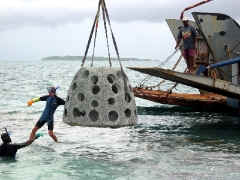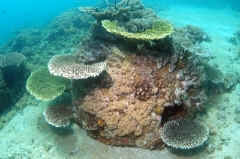I have heard of sleeping with the fishes but how would you like to be turned into a reef. Help the sea, help the sea life and help the environment in general. Kind of hard for relatives to visit but I guess they give you photos:
http://www.welt.de/english-news/article2615803/Sea-burials-help-rebuild-reefs.html
Sea burials help rebuild reefs
23.October 2008, 15:21
A company is marketing a service for those who want to help the environment in the afterlife, or forever be part of the memories at a sports stadium. They are offering a burial service that is supposed to be an environmentally friendly and less expensive alternative to traditional burials.
How is it done? Cremated remains are mixed into the concrete used to make so-called reef balls that it places at sites along the U.S. East Coast.
Tags
Those interested in helping build a reef in a body of water don’t have to wait until they die, said Eternal Reefs CEO George Frankel.
“Not at all, but when you do, it is a great way to help the bay,“ Frankel said.
The concept developed from reef-building efforts by the Reef Ball Foundation, which has placed more than a half-million of the concrete domes worldwide. Many want to mark a birth or other special occasion, while others simply want to foster underwater life. A memorial reef ball costs between $2,495 and $6,495, although the cost of cremation is not included, he said.
The Chesapeake Bay site on the U.S. East Coast where eight of the memorials were placed earlier this month, for example, already has about 600 put there by a variety of groups and organizations above the rubble from Memorial Stadium, the former home of the Baltimore Orioles baseball team in Maryland.
The burial service is one of a growing number of funeral alternatives ranging from having your ashes launched into space, compressed into a diamond or buried in a biodegradable urn. In the waters off Miami, the Neptune Memorial Reef offers an underwater burial place for cremated remains, as well as an attraction for divers who can swim among its gates, paths and statuary.
Sylvia Rennick of Kings Mountain, North Carolina, said the idea of her son’s memorial helping the Chesapeake Bay appealed to her more than a traditional cemetery plot.
“You’re around live things, it’s not all dead,“ Rennick said before her son’s memorial was lowered by crane onto the reef under sunny skies as family members threw flowers into the bay and read poems.
Afterward, she said the crew gave another of her sons the chart location of the site and he planned to visit it when he went fishing.
:}
They borrowed the idea from these folks:
http://www.reefball.org/index.html
The Reef Ball Foundation is a 501(c) 3 publicly supported non-profit and international environmental NGO working to rehabilitate marine reefs.
Our mission is to rehabilitate our world’s oceanreef ecosystems and to protect our natural reef systems using Reef Ball artificial reef technologies. Reef Balls are artificial reef modules placed in the ocean to form reef habitat.
We have placed Reef Balls™ in 59+ countries and our projects have a global reach of 70+ countries. We have conducted over 3,500 projects and deployed over 1/2 million Reef Balls.
Our projects include designed artificial reefs, ground breaking coral propagation and planting systems, estuary restoration, red mangrove plantings, oyster reef restoration, erosion control (often beach erosion), and expert collaberation on a variety of oceanic issues.
We work with governments, other NGOs, businesses, schools, research institutes, private individuals and community organizations and emphasize education on preserving and protecting our natural reefs.
(WIKI Reef Ball Foundation for history/facts)
NEW! Reef Ball “Live” Updates
Post or View Current Reef Ball Project Activities.
Our Chairman posts updates here on a regular basis.
:}
Here is what they look like, new with you in them.
:}
Here is what they look like after you have been in the reef for awhile.
:}
If you are looking for other companies willing to burn you, put you in cement shoes and plant you in the ocean:
http://www.eternalreefs.com/about/foundation.html
ETERNAL REEFS
Our Story
Eternal Reefs began simply. In the late 1980’s a pair of college roommates from the University of Georgia often went diving off the Keys in Florida on breaks. Over the years of diving they saw significant deterioration and degradation of the reefs they were visiting. Don Brawley, founder of Eternal Reefs realized the reefs needed help. A decision was made to do something about the reefs’ declining health.
Once the friends were out of school they began to talk about what contributions they could make that would help protect and restore these fragile eco-systems. Creating a material and system that would replicate the natural marine environment that supports coral and microorganism development was what they decided to do. And thus the concept of the Reef Ball was formed – to directly rehabilitate and rebuild the dying reefs and to add new habitat to the marine environment.
They faced two primary design challenges. Stability would be crucial. The design needed to be capable of absorbing and dissipating energy in the marine environment without moving. It would need to withstand not just the normal tidal and current flows, but also major storms and the dynamic energy impacts that accompany them.
In 1990, the Reef Ball Development Group and the Reef Ball Foundation completed the first Reef Ball project near Ft. Lauderdale, Florida. Since that time, there have been over 3,500 projects worldwide with more than 400,000 Reef Balls placed on the ocean floor. With years of documented history of stability and habitat development, Reef Balls have become the world standard for fisheries programs, coral restoration and habitat development projects.
In 1998, Carleton Glen Palmer, Don Brawley’s father-in-law, talked about having his cremated remains put in a reef. As Carleton put it, “I can think of nothing better than having all that action going on around me all the time after I am gone – just make sure that the location has lots of red snapper and grouper.” Shortly after Carleton made this request, he passed away.
NEPTUNE MEMORIAL REEF
The Neptune Memorial Reef project is the largest man made reef ever conceived and provides an extraordinary living resting place for the departed, an environmental and ecological masterpiece, a superb laboratory for marine biologists, students, researchers and ecologists, and an aesthetically exquisite, world-class destination for visitors from all walks of life.
:}


